|

Archeological Museum
of Herakleion
The Archeological
Museum of Herakleion contains a unique collection of ancient objects from excavations
carried out in all parts of Crete including the
archeological sites of Knossos, Phaistos,
Gortyn and many others. The exhibits come mainly
from the prehistoric Minoan era which takes its name from
the legendary Cretan king, Minos. The museum is divided into
20 galleries containing finds from palaces, houses, tombs,
and caves, arranged in groups according to period and
provenance. The exhibits cover a period of 5,000 years, from
the Neolithic era to the Greco-Roman period and include examples of pottery, stone
carving, seal engraving (one of the miniature arts at which
the Minoans excelled), gold work remarkable for the
excellence of its technique and the variety of its subjects,
metal work (household utensils, tools, weapons, and sacred
axes, carefully and ingeniously made), and frescos.
Click on the thumbnails below in order to see pictures of the exhibits in the Archeological
Museum of Herakleion. Use your browser's back button
to return to this page.



|
|
|
|
|
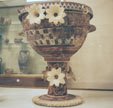 Krater
with flowers in relief from the Palace
of Phaistos, evidentially the most flourishing of the palaces at this
time. The krater is one of the most important examples of Kamares
ware, objects of exceptional workmanship, truly "royal"
utensils, which no doubt adorned the banquet halls of the Palace of
Phaistos. Kamares is a new style of pottery regarded as one of the
most decorative pottery styles of the ancient world with its chief characteristic
being polychrome decoration. The krater is dated to the First
Palace Period (1900 - 1700 BCE). Krater
with flowers in relief from the Palace
of Phaistos, evidentially the most flourishing of the palaces at this
time. The krater is one of the most important examples of Kamares
ware, objects of exceptional workmanship, truly "royal"
utensils, which no doubt adorned the banquet halls of the Palace of
Phaistos. Kamares is a new style of pottery regarded as one of the
most decorative pottery styles of the ancient world with its chief characteristic
being polychrome decoration. The krater is dated to the First
Palace Period (1900 - 1700 BCE). |
|
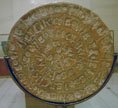 The
Phaistos Disk, one of the most valuable exhibits in the museum. The clay disk
was found at the Palace
of Phaistos. Both sides of the disc carry hieroglyphic signs which were
impressed with seal stones onto the clay while it was still wet. The
inscriptions run in a spiral form starting from the edge towards the center.
This is therefore the earliest known example of printing - a written text
reproduced with the aid of letter stamps. The words, formed by groups of
symbols, are separated by incised vertical lines. There are 45 different
symbols occurring 241 times. The symbols portray recognizable objects like
human figures and body parts, animals, weapons, and plants. Each symbol perhaps
represents a syllable or ideogram. The script has not
yet been deciphered despite the numerous attempts over the years. The
exact date of the disk is also questionable, but it probably dates to the
end of the First Palace period (17th century BCE). The
Phaistos Disk, one of the most valuable exhibits in the museum. The clay disk
was found at the Palace
of Phaistos. Both sides of the disc carry hieroglyphic signs which were
impressed with seal stones onto the clay while it was still wet. The
inscriptions run in a spiral form starting from the edge towards the center.
This is therefore the earliest known example of printing - a written text
reproduced with the aid of letter stamps. The words, formed by groups of
symbols, are separated by incised vertical lines. There are 45 different
symbols occurring 241 times. The symbols portray recognizable objects like
human figures and body parts, animals, weapons, and plants. Each symbol perhaps
represents a syllable or ideogram. The script has not
yet been deciphered despite the numerous attempts over the years. The
exact date of the disk is also questionable, but it probably dates to the
end of the First Palace period (17th century BCE). |
|
 Rhyton
(libation vessel), for use in sacred rituals, carved from a block of black steatite in the shape of a
bull's head. The bull was the most important animal in Minoan religion and
was such a familiar part of Minoan life that it survived in myths told
about Crete in later ages. The rhyton was filled with the appropriate
liquid through a hole in the neck and emptied during the ritual through
another hole in the nostrils. The details of the head are incised, the eyes are inlaid with
rock-crystal and jasper, the muzzle is inlaid with white shell
(mother-of-pearl) and the horns, now restored, were made of gilded wood.
It is an outstanding example of the skill of the Minoan lapidaries.
It was found in the little palace at Knossos and is dated to the 17th-15th
centuries BCE. Rhyton
(libation vessel), for use in sacred rituals, carved from a block of black steatite in the shape of a
bull's head. The bull was the most important animal in Minoan religion and
was such a familiar part of Minoan life that it survived in myths told
about Crete in later ages. The rhyton was filled with the appropriate
liquid through a hole in the neck and emptied during the ritual through
another hole in the nostrils. The details of the head are incised, the eyes are inlaid with
rock-crystal and jasper, the muzzle is inlaid with white shell
(mother-of-pearl) and the horns, now restored, were made of gilded wood.
It is an outstanding example of the skill of the Minoan lapidaries.
It was found in the little palace at Knossos and is dated to the 17th-15th
centuries BCE.
|
|
|
|
|
|
|
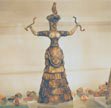 Faience
statuette of the so-called chthonian "Snake-Goddess", from the
Temple Repositories of the Palace
of Knossos. Typical features of these religious figurines are the
upraised or stretched arms wielding the crawling snakes, the thin-waisted
bodice which left the breasts bare, and the characteristic, flounced skirt
with an apron made of material with embroidered or woven decoration. There
is a small animal perched on her head. They are outstanding specimens of Minoan miniature
sculpture dated to the Second
Palace period (17th-16th centuries BCE). Faience
statuette of the so-called chthonian "Snake-Goddess", from the
Temple Repositories of the Palace
of Knossos. Typical features of these religious figurines are the
upraised or stretched arms wielding the crawling snakes, the thin-waisted
bodice which left the breasts bare, and the characteristic, flounced skirt
with an apron made of material with embroidered or woven decoration. There
is a small animal perched on her head. They are outstanding specimens of Minoan miniature
sculpture dated to the Second
Palace period (17th-16th centuries BCE).
|
|
 Five
pithoi (storage jars) in the marine and
floral style. One of the pithoi,
decorated with additional bands imitating ropes (real ropes where used on
these jars in Minoan times) carries an engraved inscription in Linear A
which begins with the ideogram for wine. This pithos was found along with
several others in the storeroom of a villa at Epano Zakros, close to the
wine press. Undoubtedly, it contained wine. They date to the Second Palace
period (1700 - 1450 BCE). Five
pithoi (storage jars) in the marine and
floral style. One of the pithoi,
decorated with additional bands imitating ropes (real ropes where used on
these jars in Minoan times) carries an engraved inscription in Linear A
which begins with the ideogram for wine. This pithos was found along with
several others in the storeroom of a villa at Epano Zakros, close to the
wine press. Undoubtedly, it contained wine. They date to the Second Palace
period (1700 - 1450 BCE).
|
|
 Pithos in the marine style
with octopus decoration from the last phase of the New Palace period (1700
- 1450 BCE), the phase immediately preceding the destruction of the
palaces, when the best marine and floral style pottery was being produced. Pithos in the marine style
with octopus decoration from the last phase of the New Palace period (1700
- 1450 BCE), the phase immediately preceding the destruction of the
palaces, when the best marine and floral style pottery was being produced.
|
|
|
|
|
|
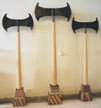 Bronze
double axes from the megaron at Nirou. The double axe in Crete, once the
instrument of sacrifice of the sacred bull, became the main religious
symbol of the Cretans (it is most often depicted together with the head of a bull). The
Minoan name for the double axe is "labrys", thus the word
labyrinth may originally have meant the "house of the double
axe". They date to the Second Palace and Post-Palace periods (1700 -
1300 BCE). Bronze
double axes from the megaron at Nirou. The double axe in Crete, once the
instrument of sacrifice of the sacred bull, became the main religious
symbol of the Cretans (it is most often depicted together with the head of a bull). The
Minoan name for the double axe is "labrys", thus the word
labyrinth may originally have meant the "house of the double
axe". They date to the Second Palace and Post-Palace periods (1700 -
1300 BCE). |
|
 Gold
and silver votive double axes dated to the Second Palace and Post-Palace
Periods (1700 - 1300 BCE). Gold
and silver votive double axes dated to the Second Palace and Post-Palace
Periods (1700 - 1300 BCE). |
|
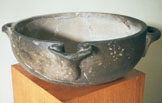 Stone vessel from central Crete dated to the Second Palace and Post-Palace
Periods (1700 - 1300 BCE).
Stone vessel from central Crete dated to the Second Palace and Post-Palace
Periods (1700 - 1300 BCE). |
|
|
|
|
|
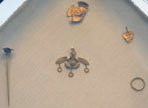 A
collection of extremely important gold jewelry from various parts of
eastern and central Crete represents the art of the Minoan goldsmith at
its zenith. The most important piece in the case, and one of the most
famous exhibits in the museum, is the pendant from the Old Palace cemetery
at Chrysolakkos near Malia which is in the shape of two bees or wasps
storing away a drop of honey in a comb. Also from Malia is a fine pin with
a flower head. The jewelry is dated to the Second Palace and Post-Palace
Periods (1700 - 1300 BCE). A
collection of extremely important gold jewelry from various parts of
eastern and central Crete represents the art of the Minoan goldsmith at
its zenith. The most important piece in the case, and one of the most
famous exhibits in the museum, is the pendant from the Old Palace cemetery
at Chrysolakkos near Malia which is in the shape of two bees or wasps
storing away a drop of honey in a comb. Also from Malia is a fine pin with
a flower head. The jewelry is dated to the Second Palace and Post-Palace
Periods (1700 - 1300 BCE). |
|
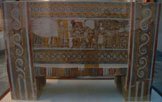 The Aghia Triada sarcophagus,
the only stone sarcophagus ever to have been found in Crete. It is wholly
covered in plaster and painted in fresco. It was found in a relatively unimportant
tomb in Aghia Triada, but no doubt it was originally used for the burial
of a prince during the period of Mycenaean occupation of Crete. The
painted frieze around the sarcophagus shows all of the stages of the
sacred ceremony which was performed at the burial of important personages.
In the center of this side, is a scene of a bull sacrifice. The bull lies
trussed up on a table, already dead, and the blood which is pouring from
its neck is being collected in a vase. Two wild goats, tied up below the
table, await a similar fate. A woman at the head of the procession extends
her arms in a ritual gesture towards the slaughtered animal. On the right
another woman, dressed in an animal skin, offers a basket of fruit and a
vessel as a bloodless sacrifice at an altar. The altar is placed near the
fence around the sacred tree, which is crowned with sacred horns, and in
front of a tall column supporting a double axe. The black bird perched on
top of the axe symbolizes the epiphany of the goddess. Close by is the
enclosure of a sacred tree, topped by horns of consecration. The
sarcophagus dates to 1600 - 1400 BCE. The Aghia Triada sarcophagus,
the only stone sarcophagus ever to have been found in Crete. It is wholly
covered in plaster and painted in fresco. It was found in a relatively unimportant
tomb in Aghia Triada, but no doubt it was originally used for the burial
of a prince during the period of Mycenaean occupation of Crete. The
painted frieze around the sarcophagus shows all of the stages of the
sacred ceremony which was performed at the burial of important personages.
In the center of this side, is a scene of a bull sacrifice. The bull lies
trussed up on a table, already dead, and the blood which is pouring from
its neck is being collected in a vase. Two wild goats, tied up below the
table, await a similar fate. A woman at the head of the procession extends
her arms in a ritual gesture towards the slaughtered animal. On the right
another woman, dressed in an animal skin, offers a basket of fruit and a
vessel as a bloodless sacrifice at an altar. The altar is placed near the
fence around the sacred tree, which is crowned with sacred horns, and in
front of a tall column supporting a double axe. The black bird perched on
top of the axe symbolizes the epiphany of the goddess. Close by is the
enclosure of a sacred tree, topped by horns of consecration. The
sarcophagus dates to 1600 - 1400 BCE. |
|
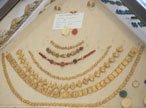 A collection of necklaces of pure gold with beads of glass paste in a
variety of shapes: spherical, amygdaloidal, or imitating papyrus flowers,
lilies or double Argonauts. The gold beads in the form of rosettes are not
from necklaces, but were used to decorate the edges of dresses. They are
dated to the Second Palace and Post-Palace Periods (1450 - 1300 BCE).
A collection of necklaces of pure gold with beads of glass paste in a
variety of shapes: spherical, amygdaloidal, or imitating papyrus flowers,
lilies or double Argonauts. The gold beads in the form of rosettes are not
from necklaces, but were used to decorate the edges of dresses. They are
dated to the Second Palace and Post-Palace Periods (1450 - 1300 BCE). |
|
|
|
|
|
 A
helmet made of rows of boars tusks sewn into a leather base, a type which
was extremely common in Mycenaean Greece. They were very familiar to Homer
who gives a vivid description of the boars' tusk helmet worn by the Cretan
hero, Meriones. It is dated to the Second Palace and Post-Palace Periods
(1450 - 1300 BCE). A
helmet made of rows of boars tusks sewn into a leather base, a type which
was extremely common in Mycenaean Greece. They were very familiar to Homer
who gives a vivid description of the boars' tusk helmet worn by the Cretan
hero, Meriones. It is dated to the Second Palace and Post-Palace Periods
(1450 - 1300 BCE).
|
|
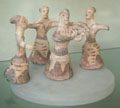 A
model of terracotta figurines from Palaikastro represents a circular dance
being performed by women holding one another's shoulders. In the middle of
the circle is a woman playing the lyre. The model reminds one immediately
of modern Cretan dances. It is dated to the Post-Palace period (1400 -
1100 BCE). A
model of terracotta figurines from Palaikastro represents a circular dance
being performed by women holding one another's shoulders. In the middle of
the circle is a woman playing the lyre. The model reminds one immediately
of modern Cretan dances. It is dated to the Post-Palace period (1400 -
1100 BCE). |
|
|
|
|
|
|
|
© All pictures are Copyright 2000 Grisel Gonzalez and Jeff
Prosise
|